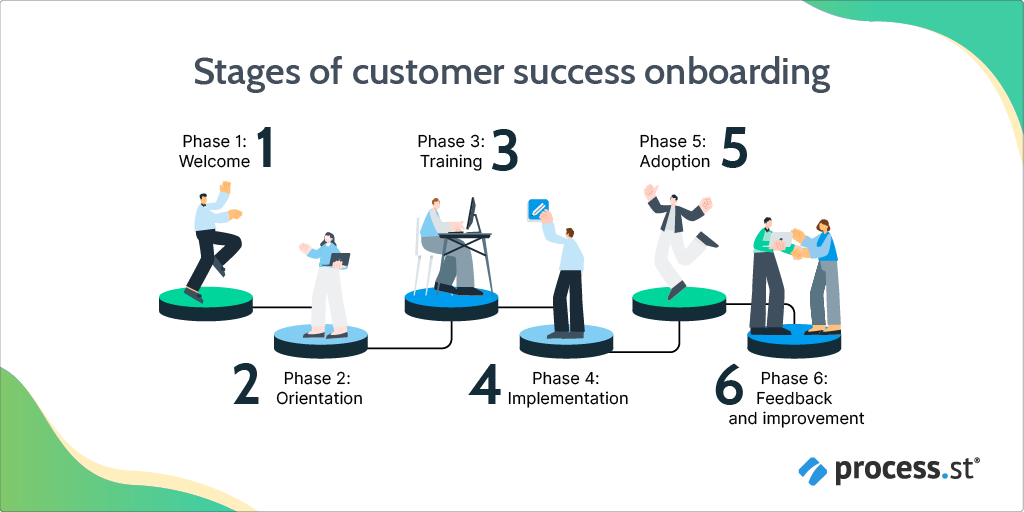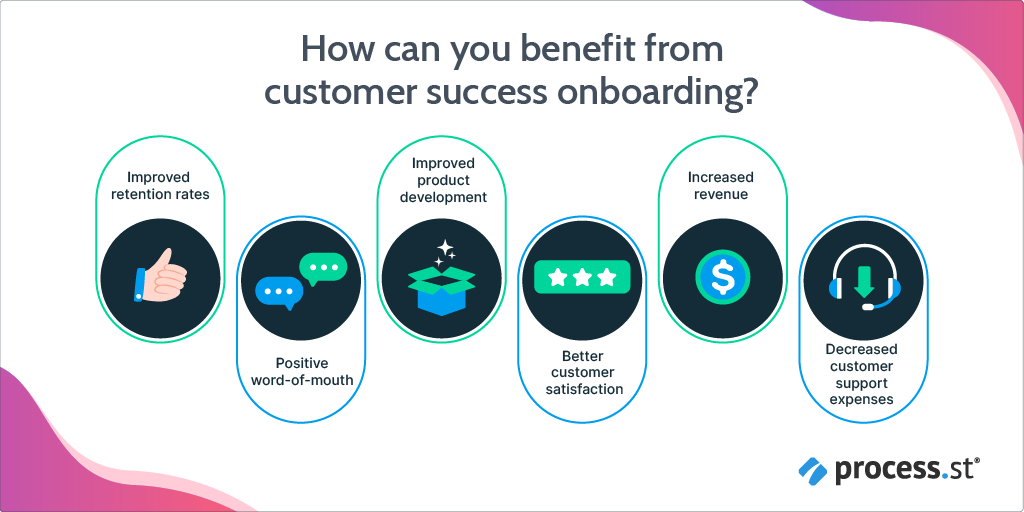Engage, retain, & satisfy customers with our easy-to-use no-code platform.
How to Maximize Loyalty with Customer Success Onboarding
In today’s fast-paced business environment, acquiring new customers is important. But retaining them is even more crucial. This is where customer success onboarding comes in. Effective onboarding can help businesses provide a positive and engaging experience for new customers. This helps to increase customer satisfaction and retention.
However, creating an effective customer success onboarding program can be challenging. From designing the right onboarding process to selecting the right tools and tracking performance, there are many factors to consider.
We’re exploring the importance of customer success onboarding, the stages involved in the process, the challenges businesses face, and the best practices and tools for successful onboarding.
What is customer success onboarding?
Customer success onboarding refers to the process of ensuring that new customers have a positive experience when they first begin using a product or service. The goal of customer success onboarding is to:
- Help customers become familiar with the product or service
- Understand how to use it effectively
- Achieve their desired outcomes
Overall, the goal of a customer onboarding process is to help new customers feel confident and satisfied with the product or service. This then encourages your customers to continue using it and become more loyal over time.
Why is customer success onboarding important?
Customer success onboarding is important for several reasons:
Setting expectations
Effective onboarding sets the right expectations for new customers. It helps them understand what to expect from your product or service, how to use it, and how to get the most value out of it. This can prevent frustration and dissatisfaction down the line.
Retention
Onboarding helps to reduce churn rates by ensuring customers are properly onboarded and understand the value of your product or service. Customers are more likely to stay with you when they feel confident and supported in using your product.
User adoption
Your customer onboarding drives user adoption by teaching customers how to use your product effectively. Customers are more likely to use a product when they understand how it works and the value it provides.
Referrals
A positive onboarding experience can lead to referrals and positive word-of-mouth marketing. Satisfied customers are more likely to recommend your product to others.
Upselling and cross-selling
Onboarding can help identify opportunities for upselling and cross-selling. That’s because your client onboarding identifies gaps in customer knowledge and offers additional products or services to meet their needs.
Stages of customer success onboarding

There are several stages of customer success onboarding which can vary depending on the company and the product or service being offered. Here are some common stages:
Welcome
The first stage of onboarding is to welcome the new basic or marketing client and introduce them to your company and product. This can include sending a welcome email or video or scheduling a call with a customer success representative.
Orientation
The next stage is orientation, where the customer is introduced to the key features and benefits of your product or service. This can include a product demo, a guided tour of the platform, or a series of tutorial videos.
Training
Once the customer has a basic understanding of your product, the next stage is training. This can involve more in-depth training on specific features or use cases or personalized training based on the customer’s specific needs.
Implementation
The implementation stage involves setting up the product or service for the customer and ensuring that it is integrated properly with their existing systems. This can include technical support and assistance with data migration.
Adoption
By the adoption stage, you want your marketing client to start using your product or service on their own. It’s important to monitor their usage and provide support as needed to ensure a smooth transition.
Review and feedback
You want to review the customer’s experience and gather feedback during the final stage of onboarding. This can help identify areas for improvement and ensure that the customer is satisfied with the onboarding process.
Benefits of customer success onboarding

Good customer success onboarding can bring several benefits to both the customer and the company, including:
Improved customer satisfaction
When customers are onboarded effectively, they are more likely to feel satisfied with your product or service. They have a better understanding of what to expect and how to use your product, which reduces frustration and increases confidence.
Increased customer retention
An effective client onboarding process improves customer retention rates by helping customers realize the value of your product or service. When customers see the benefits of using your product, they are more likely to continue using it.
Reduced customer support costs
A good customer success onboarding experience reduces the number of support requests from new customers. By teaching customers how to use your product effectively, they are less likely to encounter problems or require assistance.
Higher revenue
You nurture higher revenue opportunities when you have an effective customer success onboarding program in place. That’s because effective onboarding can lead to upselling and cross-selling opportunities. When customers understand your product, they’re more likely to purchase additional products or services.
Positive word-of-mouth
Satisfied customers are more likely to recommend your product or service to others, leading to positive word-of-mouth marketing.
Improved product development
Effective onboarding can also improve product development by identifying areas where customers struggle or have questions. This feedback can be used to improve the product and make it more user-friendly.
Challenges of customer success onboarding

There are several challenges associated with customer success onboarding, including:
Time constraints
Onboarding is time-consuming. It can be challenging to balance the needs of new customers with the demands of existing customers. And this is all while your ongoing business operations continue.
Complex products or services
If your product or service is complex, it can be difficult to communicate its value and teach customers how to use it effectively. This can lead to frustration and a lack of adoption.
Technical issues
Technical issues can arise during onboarding, such as integration problems or data migration issues. These can delay the onboarding process and lead to customer dissatisfaction.
Limited resources
Small companies or startups may not have the resources to provide extensive customer success onboarding support, which may impact the quality of the onboarding experience.
Language barriers
Language barriers might make it challenging to communicate effectively if you have customers from different countries or regions. This may result in an unsuccessful customer success onboarding experience.
Unresponsive customers
Some customers may not be responsive during the onboarding process. This makes it difficult to identify and resolve issues or provide effective support.
Best practices for customer success onboarding
Here are some best practices for customer success onboarding:
Personalize the onboarding experience
Take the time to understand each customer’s unique needs and goals, and tailor the onboarding experience to their specific situation. This could involve:
- Customizing training materials
- Offering personalized support
- Providing relevant resources and documentation
Set clear expectations
Make sure customers understand what to expect during the onboarding process. You should provide them with:
- A timeline
- The goals and objectives they can expect to receive
- The roles and responsibilities of both the company and the customer during onboarding
Communicate frequently
Regular communication is key to a successful onboarding experience. Keep customers informed of progress, provide timely updates, and respond promptly to questions or concerns.
Provide proactive support
Anticipate customer needs and provide proactive support to address areas of concern before they become problems. This involves providing relevant resources, offering additional training, or connecting customers with experts or other resources.
Measure success
Define key performance indicators (KPIs) for onboarding success. This might include:
- Adoption rate
- Time-to-value
- Customer satisfaction
You want to track progress against these metrics and use this data to identify areas for improvement.
Continuously improve
Onboarding is an ongoing process, and it’s important to continuously evaluate and improve the process based on customer feedback and changing business needs. Incorporate feedback from customers, support teams, and other stakeholders to refine the onboarding process and ensure ongoing success.
Are customer success onboarding tools useful?
Tools for customer success onboarding can be a great asset to any business. As we already know, effective customer success onboarding is critical to the success of any business, and using the right tools helps to streamline and optimize the process.
Here are some of the benefits of using tools for customer success onboarding:
Improved efficiency
Tools such as automation software and digital adoption platforms can help automate tasks and provide interactive, personalized experiences for new customers. This helps to streamline the onboarding process and improve efficiency.
Consistency
Onboarding tools can help ensure that every customer receives the same level of care and attention during the onboarding process. You create a consistent experience for all customers when investing in onboarding tools, which can improve overall satisfaction and retention.
Data-driven decision making
Customer feedback tools and analytics platforms can help businesses collect data and identify areas for improvement in their onboarding process. This data can be used to make data-driven decisions and optimize the onboarding process over time.
Personalization
Some tools, such as digital adoption platforms, can provide a personalized onboarding experience for each enterprise client. You help customers feel more engaged and connected to the product when you invest in an onboarding tool. More time can be spent on building a rapport with your customer while these tools streamline the more tedious tasks involved in onboarding.
Must-have features for customer success onboarding tools
Here are some features you want to search for in customer success software:
Create and customize onboarding workflows
You want customer onboarding software that lets you create customizable onboarding workflows for new customers. These customer onboarding templates should be tailored to the specific needs and requirements of each customer and can include tasks such as:
- Setting up the account
- Configuring settings
- Completing training modules
Automate onboarding tasks
Your customer success tool should automate onboarding tasks. This includes tasks, such as
- Sending welcome emails
- Assigning tasks to team members
- Tracking progress
Automation is an important feature in a customer onboarding tool because it helps streamline the onboarding process. More streamlined processes ensure that tasks are completed in a timely and efficient manner, which is exactly what you want to achieve.
Provide training and resources
Training and resources are needed in any customer onboarding process. Your chosen tool should be able to house training modules, video tutorials, and other documentation. It’s vital that your onboarding tools help customers learn how to use your product or service effectively.
Track customer progress
With so many tasks involved in the onboarding process, it can be challenging to keep track of everything. You want to pick a customer success onboarding tool that lets you track your customer’s progress.
This helps to identify areas where your customer might be struggling or where more information/support may be required.
It’s in these areas where employees can step in to find out the issue and encourage the new customer to continue through the process as opposed to churning. Monitoring these analytics also provides insight into improvements that can be made to the onboarding process over time.







 Workflows
Workflows Projects
Projects Data Sets
Data Sets Forms
Forms Pages
Pages Automations
Automations Analytics
Analytics Apps
Apps Integrations
Integrations
 Property management
Property management
 Human resources
Human resources
 Customer management
Customer management
 Information technology
Information technology


